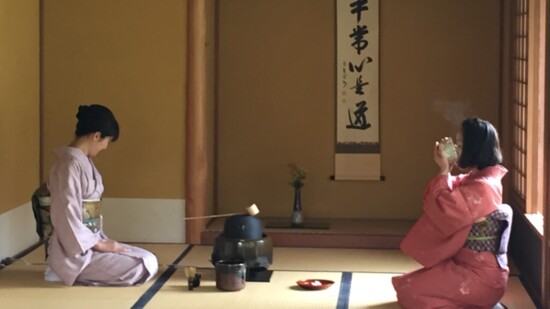In my personal journey of ancestral discovery, Kyoko Matsuda graciously invited me to her Mercer Island home and tearoom to learn the ways of the Japanese Tea Ceremony. We started at the beginning.
Amidst the tranquil corridors of a monastery, a serendipitous revelation unfolded, changing the course of history.
Kyoko Matsuda: Monks (kind of) accidentally discovered caffeine. Drinking matcha at the monastery helped them to stay awake for meditation.”
This discovery breathed new life into their contemplative practice, offering not just a beverage but a bridge between the physical and the spiritual.
KM: Tea was a different form at that time. More like medicine with a thick consistency, like Congee (Chinese Rice porridge). Crossing from China to Japan wasn't easy. Supply ran out and the taste wasn't sweet enough for the Japanese people.
The 12th century illuminated a new chapter. Emerging from monastic solitude, matcha graced high society. With a ceremonious flourish, it became emblematic of prestige and exclusivity.
KM: Zen monks introduced matcha as a health benefit and only to high society people, Shogun. Using the network of the temple, it became very popular (and) only amongst high society. Samurai swords couldn't enter the tearoom. Matcha was first a very expensive thing!
KM: The tearoom was status. Utensils were imported from China and Korea and were all very expensive, like art. The tearoom was a way for wealthy people to show off and became a party, entertainment.
Yet, the most transformative epoch awaited. In the 16th century, Sen no Rikyu authored a new narrative. Stripping away the flamboyance, he embraced imperfections and celebrated simplicity, birthing wabi-sabi. The practice transcended social confines, allowing all to partake in its profound teachings.
KM: Chanoyu was only practiced with men up until 150 years ago. And, amongst High Society only. 150 years ago, Japan opened the country to the West. At this time, Samurai ceased to exist. No more swords. The samurai were kind of out of a job. As Japan focused on the Western way of living, a need to educate the public surfaced, particularly for women. Tea ceremony became an educational curriculum and part of Finishing school. Gradually becoming a women's practice for "Women of style".
KM: Nowadays, anybody can practice. The Tea Ceremony has become artful, Like a musical instrument, ballet. 85% of Tea Ceremony practitioners are women. Now thought of as a "woman's practice".
Kyoko Matsuda's story began to intertwine with the tea ceremony. Her journey, once familiar, found rejuvenation through an encounter with Sensei Chieko Mihori in Florida. Palm Beach County is home to the Morikami Museum and Japanese Tea Garden.
KM: One of the things that anchored me when I came to America was meeting my teacher, Chieko Mihori. I didn't start wanting to teach. But it stayed inside and now, the rest of my life, I want to do it!"
Kyoko moved to Washington with her husband, Matthew Goldbach. Embarking on a path that resonated with nature's cadence.
MG: Initially, it was just for summers. We bought a place in Bellingham, just to stay 3 months per year.
KM: And I fell in love……with the area. (They grinned.)
For reasons she can’t explain, Kyoko says she always wanted to be on Mercer Island.
KM: So green, high trees, and the people were so nice.
She also recalls wanting to be closer to Seattle and Japan. So, something pulled her to Mercer Island. Quite serendipitous.
Kyoko's mission to share chanoyu shone ever brighter. Her workshops, private sessions, and cultural events wove its threads into lives across the spectrum. She really touches her students. During the pandemic, her student, Kenji founded the University of Washington Chanoyu Club, an embodiment of Kyoko's indomitable influence. Kenji says, "Matsuda Sensei pushed me to do it".
Yet, it is within Kyoko's tearoom that her story finds its crescendo. Each element, from the meticulously arranged utensils to the scrolls adorning the alcove, speaks of reverence. Traditional sliding doors invite in the play of light, casting a serene aura.
KM/MG: We did everything step-by-step because this is the Grandmasters design. Dimensions down to the inch. Tatami mats cut to same specs. Everything from the wallpaper paper, stucco, and bamboo. All spread the same way as the Grandmasters. All Carpentry was even done with traditional tools.
The tearoom reverberates with wakei seijaku—respect, purity, tranquility, and harmony. Here, Kyoko's legacy entwines with ancestral teachings. It is a space where seekers transcend time, basking in a moment that bridges past, present, and future.
Thus, as guests step into Kyoko's tearoom, they traverse more than the physical space.
Kyoko refers to this as “Crossings”. Where you are leaving daily life and job. Where you begin focusing on this moment and very simple things.
“Do” implies a road that stretches far beyond the horizon, winding through time and space without an endpoint. For the tea ceremony, "Do" beautifully symbolizes the perpetual quest for self-improvement, learning, and growth. Just as a path stretches ahead, the pursuit of mastery in the art of chanoyu is an unending journey, inviting practitioners to explore, evolve, and find deeper meaning with every step.
"Just enjoy this moment. The Japanese word "Do," when translated, holds profound significance. Beyond its literal meaning of "path" or "way," it encapsulates a philosophy that the journey is never truly complete." - Kyoko Matsuda








